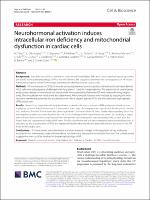| dc.contributor | Vall d'Hebron Barcelona Hospital Campus |
| dc.contributor.author | Tajes, M. |
| dc.contributor.author | Díez‑López, C. |
| dc.contributor.author | Enjuanes, Cristina |
| dc.contributor.author | Moliner, Pedro |
| dc.contributor.author | Ferreiro, José Luis |
| dc.contributor.author | Garay, A. |
| dc.contributor.author | Yañez Bisbe, Laia |
| dc.contributor.author | Benito Villabriga, Begoña |
| dc.date.accessioned | 2022-01-12T17:41:16Z |
| dc.date.available | 2022-01-12T17:41:16Z |
| dc.date.issued | 2021-05-17 |
| dc.identifier.citation | Tajes M, Díez-López C, Enjuanes C, Moliner P, Ferreiro JL, Garay A, et al. Neurohormonal activation induces intracellular iron deficiency and mitochondrial dysfunction in cardiac cells. Cell Biosci. 2021 May 17;11:89. |
| dc.identifier.issn | 2045-3701 |
| dc.identifier.uri | https://hdl.handle.net/11351/6770 |
| dc.description | Cardiac cell; Iron deficiency; Neurohormonal activation |
| dc.description.abstract | Background
Iron deficiency (ID) is common in patients with heart failure (HF) and is associated with poor outcomes, yet its role in the pathophysiology of HF is not well-defined. We sought to determine the consequences of HF neurohormonal activation in iron homeostasis and mitochondrial function in cardiac cells.
Methods
HF was induced in C57BL/6 mice by using isoproterenol osmotic pumps and embryonic rat heart-derived H9c2 cells were subsequently challenged with Angiotensin II and/or Norepinephrine. The expression of several genes and proteins related to intracellular iron metabolism were assessed by Real time-PCR and immunoblotting, respectively. The intracellular iron levels were also determined. Mitochondrial function was analyzed by studying the mitochondrial membrane potential, the accumulation of radical oxygen species (ROS) and the adenosine triphosphate (ATP) production.
Results
Hearts from isoproterenol-stimulated mice showed a decreased in both mRNA and protein levels of iron regulatory proteins, transferrin receptor 1, ferroportin 1 and hepcidin compared to control mice. Furthermore, mitoferrin 2 and mitochondrial ferritin were also downregulated in the hearts from HF mice. Similar data regarding these key iron regulatory molecules were found in the H9c2 cells challenged with neurohormonal stimuli. Accordingly, a depletion of intracellular iron levels was found in the stimulated cells compared to non-stimulated cells, as well as in the hearts from the isoproterenol-induced HF mice. Finally, neurohormonal activation impaired mitochondrial function as indicated by the accumulation of ROS, the impaired mitochondrial membrane potential and the decrease in the ATP levels in the cardiac cells.
Conclusions
HF characteristic neurohormonal activation induced changes in the regulation of key molecules involved in iron homeostasis, reduced intracellular iron levels and impaired mitochondrial function. The current results suggest that iron could be involved in the pathophysiology of HF. |
| dc.language.iso | eng |
| dc.publisher | BMC |
| dc.relation.ispartofseries | Cell and Bioscience;11 |
| dc.rights | Attribution 4.0 International |
| dc.rights.uri | http://creativecommons.org/licenses/by/4.0/ |
| dc.source | Scientia |
| dc.subject | Anèmia ferropènica |
| dc.subject | Insuficiència cardíaca |
| dc.subject.mesh | Anemia, Iron-Deficiency |
| dc.subject.mesh | Heart Failure |
| dc.subject.mesh | Iron-Regulatory Proteins |
| dc.title | Neurohormonal activation induces intracellular iron deficiency and mitochondrial dysfunction in cardiac cells |
| dc.type | info:eu-repo/semantics/article |
| dc.identifier.doi | 10.1186/s13578-021-00605-5 |
| dc.subject.decs | anemia ferropénica |
| dc.subject.decs | insuficiencia cardíaca |
| dc.subject.decs | proteínas reguladoras del hierro |
| dc.relation.publishversion | https://doi.org/10.1186/s13578-021-00605-5 |
| dc.type.version | info:eu-repo/semantics/publishedVersion |
| dc.audience | Professionals |
| dc.contributor.organismes | Institut Català de la Salut |
| dc.contributor.authoraffiliation | [Tajes M, Ferreiro JL] Bio Heart Cardiovascular Diseases Research Group, Bellvitge Biomedical Research Institute (IDIBELL), L’Hospitalet de Llobregat, Barcelona, Spain. Cardiology Department, Bellvitge University Hospital, L’Hospitalet de Llobregat, Barcelona, Spain. [Díez-López C] Bio Heart Cardiovascular Diseases Research Group, Bellvitge Biomedical Research Institute (IDIBELL), L’Hospitalet de Llobregat, Barcelona, Spain. Cardiology Department, Bellvitge University Hospital, L’Hospitalet de Llobregat, Barcelona, Spain. Advanced Heart Failure and Heart Transplant Unit, Cardiology Department, Bellvitge University Hospital, L’Hospitalet de Llobregat, Barcelona, Spain. Department of Clinical Sciences, School of Medicine, University of Barcelona, Barcelona, Spain. [Enjuanes C, Moliner P, Garay A] Bio Heart Cardiovascular Diseases Research Group, Bellvitge Biomedical Research Institute (IDIBELL), L’Hospitalet de Llobregat, Barcelona, Spain. Cardiology Department, Bellvitge University Hospital, L’Hospitalet de Llobregat, Barcelona, Spain. Community Heart Failure Program, Cardiology Department, Bellvitge University Hospital, L’Hospitalet de Llobregat, Barcelona, Spain. [Yañez-Bisbe L] Programa de Biologia Vascular i Metabolisme, Vall d’Hebron Institut de Recerca (VHIR), Barcelona, Spain. [Benito B] Programa de Biologia Vascular i Metabolisme, Vall d’Hebron Institut de Recerca (VHIR), Barcelona, Spain. Servei de Cardiologia, Vall d’Hebron Hospital Universitari, Barcelona, Spain. Departament de Medicina, Universitat Autònoma de Barcelona, Bellaterra, Spain |
| dc.identifier.pmid | 34001233 |
| dc.identifier.wos | 000657739600003 |
| dc.rights.accessrights | info:eu-repo/semantics/openAccess |

